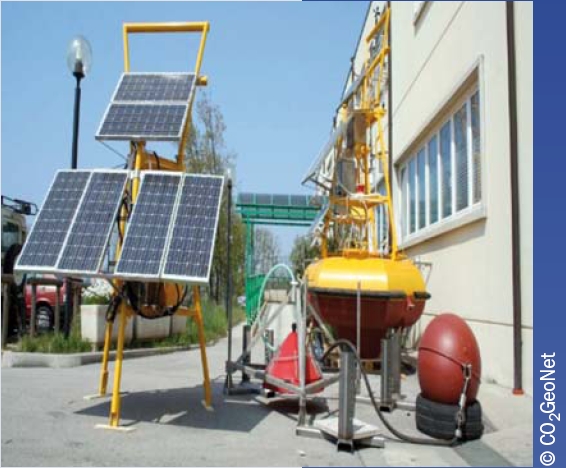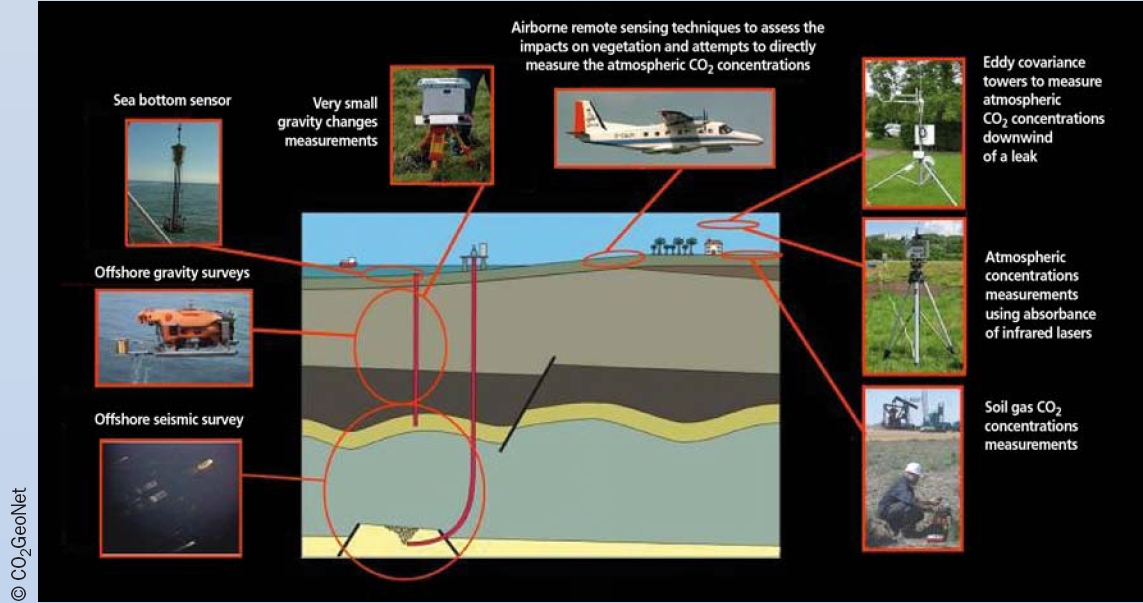
|
How can we monitor the storage
site at depth and at the surface?
|
All CO2 storage sites will need to be monitored for operational, safety, environmental, societal and economic reasons. A strategy has to be drawn up to define what exactly will be monitored and how.
Why do we need monitoring?
Monitoring site performance will be critical to ensure that the principal goal of CO2 geological storage is attained, namely the long-term isolation from the atmosphere of anthropic CO2. The reasons for monitoring storage sites are numerous, including:
Operational: to control and optimize the injection process.
Safety and environmental: to minimize or prevent any impact on people, wildlife and ecosystems in the vicinity of a storage site, and to ensure the mitigation of global climate change.
Societal: to provide the public with the information needed to understand the safety of the storage site and to help gain public confidence.
Financial: to build market confidence in CCS technology and to verify the stored volumes of CO2 so that they are credited as 'avoided emissions' in future phases of the European Unions Emission Trading Scheme (ETS).
Monitoring of both the initial state of the environment (so-called baseline) and the subsequent site performance is an important regulatory requirement in the EC Directive on CCS, published on 23rd April 2009. Operators need to be able to demonstrate that the storage performance conforms to regulations and will continue to do so over the long term. Monitoring is an important component that will reduce uncertainties in site performance, and thus it should be strongly linked to safety management activities.
What are the monitoring targets?
Monitoring can be focused on various targets and processes in different parts of the site, such as:
Plume imaging tracking of the CO2 as it migrates from the injection point. This provides key data for calibrating models that predict the future distribution of CO2 at the site. Many mature techniques are available, most notably repeat seismic surveys, which have been successfully applied at several demonstration and pilot-scale projects (Fig. 1).

|
Figure 1
Seismic imaging to monitor the CO2 plume* at the Sleipner pilot before injection (which began in 1996) and after injection (respectively 3 and 5 years later).
|
Cap-rock integrity necessary to evaluate if the CO2 is isolated within the storage reservoir and to enable early warning of any unexpected upward CO2 migration. This can be especially important during the injection phase of a project, when reservoir pressures are significantly, but temporarily, increased.
Well integrity. This is an important issue as deep wells could potentially provide a direct pathway for CO2 migration to the surface. CO2 injection wells plus any observation wells or pre-existing abandoned wells must be carefully monitored during the injection phase and beyond to prevent sudden escape of CO2. Monitoring is also used to verify that all wells have been efficiently sealed once they are no longer required. Existing geophysical and geochemical monitoring systems, which are standard practice in the oil and gas industry, can be installed within or above wells to provide early warning and ensure safety.
Migration in the overburden. At storage sites where additional, shallower rock units have properties that are similar to those of the cap rock, the overburden may form a key component in reducing the risk of CO2 escape into the sea or the atmosphere. If monitoring in the reservoir or around the cap rock indicates an unexpected migration through the cap rock, monitoring of the overburden will be necessary. Many of the techniques used in plume imaging or monitoring cap-rock integrity can be used within the overburden.
Surface leakage and atmospheric detection and measurement. To ensure that the injected CO2 has not migrated to the surface, a range of geochemical, biochemical and remote sensing techniques is available to locate leaks, assess and monitor CO2 distribution in the soil and its dispersion in the atmosphere or the marine environment (Fig. 2).

|
Figure 2
Monitoring buoy with solar panels for energy supply, floats and device to sample gas at the bottom of the sea.
|
Quantity of stored CO2 for regulatory and fiscal purposes. Although the amount of CO2 injected can be readily measured at the wellhead, quantification in the reservoir is technically very challenging. If leakage to the near-surface occurs, then the amounts being released will have to be quantified for accounting purposes within national greenhouse gas inventories and future ETS schemes.
Ground movements and microseismicity*. The increased reservoir pressure due to CO2 injection could, in specific cases, increase the potential for microseismicity and small-scale ground movements. Microseismic monitoring techniques and remote methods (surveys from aircraft or satellites) able to measure even tiny ground distortion are available.
How is monitoring done?
A wide range of monitoring techniques has already been applied at existing demonstration and research projects. These include methods that directly monitor the CO2, and those that indirectly measure its effects on rocks, fluids and the environment. Direct measurements include the analysis of fluids from deep wells or the measurement of gas concentrations in the soil or atmosphere. Indirect methods include geophysical surveys, and monitoring pressure changes in wells or pH changes in groundwater.
Monitoring will be required for storage sites whether they are offshore or onshore. The selection of appropriate monitoring techniques will depend on the technical and geological characteristics of the site and the monitoring aims. A wide range of monitoring techniques is already available (Fig. 3), many of which are well established in the oil and gas industries; these techniques are being adapted to a CO2 context. Research into optimization of existing methods or the development of innovative techniques is also underway with the goal of improving resolution and reliability, reducing costs, automating operation, and demonstrating effectiveness.

|
Figure 3
A small selection illustrating the range of techniques available to monitor different components of a CO2 storage system.
|
Monitoring strategy
When designing a monitoring strategy, many decisions must be made that depend on the geological and engineering conditions specific to each individual site, such as reservoir geometry and depth, expected spread of the CO2 plume, potential leakage pathways, overburden geology, injection time and flow rate, and surface characteristics, such as topography, population density, infrastructure and ecosystems. Once decisions have been made regarding the most appropriate measurement techniques and locations, baseline surveys must be conducted prior to injection operations to serve as a reference for all future measurements. Finally, each monitoring programme must be flexible so that it can evolve as the storage project itself evolves. A monitoring strategy capable of integrating all these issues, while at the same time improving cost effectiveness, will form a critical component in risk analysis and the verification of site safety and efficiency.
In conclusion, we know that the monitoring of a CO2 storage site is already feasible with the many techniques that are available on the market or under development. Research is currently underway, not only to develop new tools (particularly for sea-floor use), but also to optimize monitoring performance and reduce the costs.
Source: The European Network of Excellence on the Geological Storage of CO2
<< Previous page
---
Next page >>
TOP
|





